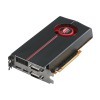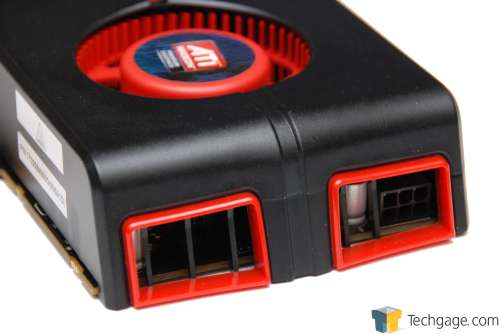- Qualcomm Launches Snapdragon 4 Gen 2 Mobile Platform
- AMD Launches Ryzen PRO 7000 Series Mobile & Desktop Platform
- Intel Launches Sleek Single-Slot Arc Pro A60 Workstation Graphics Card
- NVIDIA Announces Latest Ada Lovelace Additions: GeForce RTX 4060 Ti & RTX 4060
- Maxon Redshift With AMD Radeon GPU Rendering Support Now Available
ATI Radeon HD 5770 – DirectX 11 for the Masses

AMD may have released its first Evergreen GPUs mere weeks ago, but don’t think it’s slowing down for anybody. The company has followed-up with its first mid-range parts, belonging to the HD 5700 series. Performance is much more modest on these new cards, but no features have been scrapped. It’s all here… DirectX 11, Eyefinity and more.
Page 2 – Closer Look at ATI’s Radeon HD 5700 Series
It’s time to get into what this article’s all about… our look at ATI’s Radeon HD 5770. This is of course the company’s brand-new mid-range graphics card, and it will carry an SRP of $159, putting it right below NVIDIA’s GTX 260 in terms of retail value. Over the past few months, there have been many rumors that the HD 5770 would be comparable in performance to the HD 4870, and for the most part, that’s true. Both cards share a similar number of steam processors, but both also trade various other pros and cons, with the overall nod going towards the HD 4870.
The easiest way to look at the HD 5770 is to consider it as being half of an HD 5870, because in most regards, that’s exactly the case. The block diagram for the HD 5770 is seen above, and as you can see, it is indeed almost like the HD 5870’s, but cut in half. There are some minor detail changes, and the end result is that the HD 5870 has slightly more than double the number of transistors, but nothing is lacking from the HD 5770 from a features standpoint… only performance.
To help prove this “half” metric, take a look at the table below. Rather than comparing all four of the current HD 5000-series cards, I’d opted to single out the HD 5870 and HD 5770, as they’re both the “top card” in their respective category (mid-range vs. high-end). As you can see, the HD 5870 pretty much doubles everything, from the number of stream processors to the number of texture units and ROPs. Of course, the various performance measurements are doubled as well. The exception is the GDDR5 data rate, which remains the same as both cards feature 1GB of GDDR5, and at the same memory clock of 1200MHz. The GPU core clock is also the same on both cards, at 850MHz.
|
Specification
|
Radeon HD 5770
|
Radeon HD 5870
|
| Process |
40nm
|
40nm
|
| Transistors |
1.04B
|
2.15B
|
| Engine Clock |
850 MHz
|
850 MHz
|
| Stream Processors |
800
|
1600
|
| Compute Performance |
1.36 TFLOPS
|
2.72 TFLOPS
|
| Texture Units |
40
|
80
|
| Texture Fillrate |
34.0 GTexel/s
|
68.0 GTexel/s
|
| ROPs |
16
|
32
|
| Pixel Fillrate |
13.6 GPixel/s
|
27.2 GPixel/s
|
| Z/Stencil |
54.4 GSamples/s
|
108.8 GSamples/s
|
| Memory Type |
GDDR5
|
GDDR5
|
| Memory Clock |
1200 MHz
|
1200 MHz
|
| Memory Data Rate |
4.8 Gbps
|
4.8 Gbps
|
| Memory Bus |
128-bit
|
256-bit
|
| Memory Bandwidth |
76.8 GB/s
|
153.6 GB/s
|
| Maximum Board Power |
108W
|
188W
|
| Idle Board Power |
18W
|
27W
|
There’s one “loss” suffered by the HD 5770 that’s worth noting, though… the power consumption. The given TDP of the HD 5770 isn’t exactly half, nor would we expect it to be, but it’s impressive nonetheless… just 18W idle. Finally, we’re seeing GPU companies taking power consumption seriously. Even if you’re the furthest thing from an enviro-nut, I’m confident most would agree that a GPU idling at 18W is far better than one that idling at 80W.
I can’t stress how important these gains (or rather, losses) are, because just imagine how much power is consumed by the idle GPUs the world over, compared to what it could be like with GPUs such as these. The differences are huge. To put it in perspective, the HD 4870, which offers similar performance as the HD 5770, idles at 80W. ATI has effectively decreased idle power consumption by 77.5% in just one generation.
Wow.
Below is AMD’s current GPU line-up, including the HD 5750, also released today. You’ll notice an absolute lack of X2 cards, and that’s not an accident. In looking around the web, it’s become clear that those have been phased out, and it’s no surprise, as the HD 5870 X2 (Hemlock) is due very, very soon. Earlier, I equated the HD 5770 to being one-half of an HD 5870, and the same could almost be said when comparing the HD 5750 to the HD 5850. The primary difference is that the HD 5770 has a slower GPU clock (-25MHz), but faster memory clock (+150MHz).
AMD claims immediate availability of both of today’s launches, but I’d personally expect the HD 5770 to be much easier to acquire over the course of the next few weeks based on what I’m hearing from some vendors. We didn’t receive an HD 5750 in time for this article, but you can expect our look at it in the weeks to come.
|
Model
|
Core MHz
|
Mem MHz
|
Memory
|
Bus Width
|
Processors
|
| Radeon HD 5870 |
850
|
1200
|
1024MB
|
256-bit
|
1600
|
| Radeon HD 5850 |
725
|
1000
|
1024MB
|
256-bit
|
1440
|
| Radeon HD 5770 |
850
|
1200
|
1024MB
|
128-bit
|
800
|
| Radeon HD 5750 |
700
|
1150
|
512 – 1024MB
|
128-bit
|
720
|
| Radeon HD 4890 |
850 – 900
|
975
|
1024MB
|
256-bit
|
800
|
| Radeon HD 4870 |
750
|
900
|
512 – 2048MB
|
256-bit
|
800
|
| Radeon HD 4850 |
625
|
993
|
512 – 1024MB
|
256-bit
|
800
|
| Radeon HD 4770 |
750
|
800
|
512MB
|
128-bit
|
640
|
| Radeon HD 4670 |
750
|
900 – 1100
|
512 – 1024MB
|
128-bit
|
320
|
| Radeon HD 4650 |
600
|
400 – 500
|
512 – 1024MB
|
128-bit
|
320
|
The HD 5770 features a near-identical shroud as the already-released HD 5870 and HD 5850, and while it does a sufficient job of keeping the GPU cool, I can’t help but think of it as looking like a toy. Who can blame me? It’s a good thing the performance proves it’s the furthest thing from one.
While the HD 5870 and HD 5850 cards have two PCI-E power connectors, both the HD 5770 and HD 5750 have just one, situated inside of the top portion of the card’s chassis. Note that the similar-performing HD 4870 of last summer required two power connectors, so the power consumption differences are noticeable from a physical standpoint as well.
Just because the HD 5700 series are AMD’s mid-range cards, it doesn’t mean that the company cheapened out and removed Eyefinity support. It’s actually the opposite, with two DVI ports ready to go, along with both HDMI and DisplayPort connections as well. What’s most exciting about the company’s inclusion of this, to me, is with the HD 5750. That card is to sell for $110, and gaming performance aside, that’s one heck of a deal for a card that’s able to power 3x 2560×1600 displays. For all we know, it might be financial gurus that are picking these cards up in droves, as they typically have robust multi-monitor setups.
Before we dive into our testing results, I’ll reiterate that given the specs, we can expect the HD 5770 to fare quite nicely when compared to the HD 4870 (which retailed for $400 at its launch last summer). It’s hard to say that the HD 5770 is only a lesser-expensive HD 4870, though, because the older card lacks DirectX 11 support, has a far higher power consumption, greater temperatures, lacks Eyefinity support, nor does it offer Dolby True HD via HDMI. Overall, the HD 5770 is a win/win any way you look at it.
On the following page, we’ll tackle our system specifications and testing methods, and then we’ll kick off our results with Call of Duty: World of War.
Support our efforts! With ad revenue at an all-time low for written websites, we're relying more than ever on reader support to help us continue putting so much effort into this type of content. You can support us by becoming a Patron, or by using our Amazon shopping affiliate links listed through our articles. Thanks for your support!








